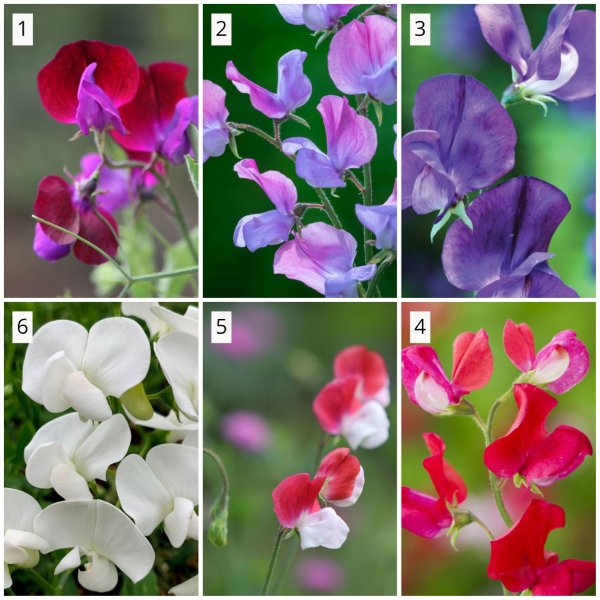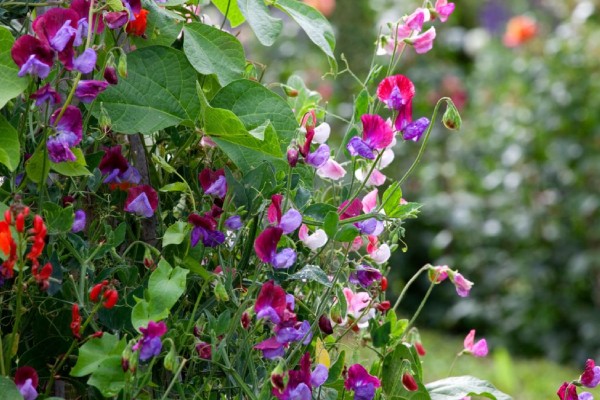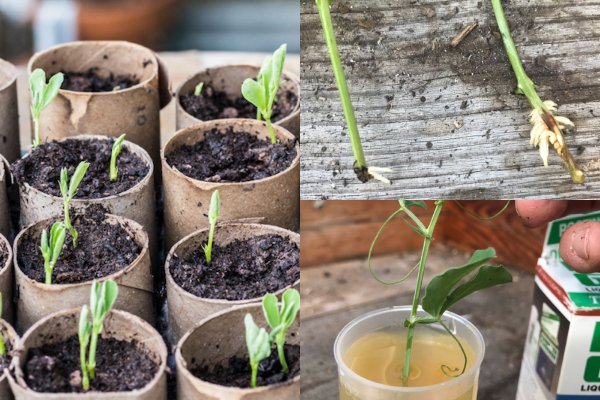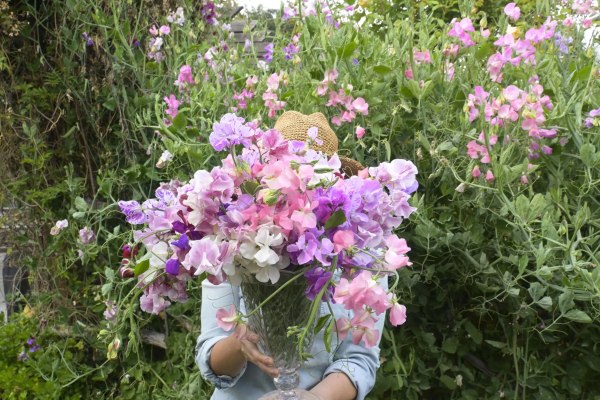Sweet Pea (Lathyrus odoratus) is a fragrant flowering plant popular for its pretty, pastel-colored blossoms. It climbs by twirling its tendrils around nearby plants and structures. Its leaves have two small leaflets, producing clusters of delicate flowers at the top. Sweet Pea is native to southwest Italy and the Mediterranean islands and belongs to the legume family. The annual sweet peas, usually Lathyrus odoratus, are very fragrant, and last for just one season. It needed to be planted again each year. Perennial types, like Lathyrus latifolius, come back year after year but generally have little or no fragrance. Similarly, some sweet peas are bushy and non-climbing. While climbing plants are often seen growing up trellises or fences or hanging over the sides of pots.
Here we discuss more on how to grow and care for Sweet peas.
Plant Description
Plant Type: Annual, Vine
Scientific Name: Lathyrus odoratus
Family: Fabaceae
Common Name: Sweet Pea, Perennial Pea, Everlasting Pea
Season: Summer, Fall
Native Area: Europe, Mediterranean
Toxicity: Toxic to humans and pets
Varieties of Sweet Pea
Lathyrus latifolius ‘White Pearl’
Lathyrus Latifolius ‘White Pearl’ is a vigorous, award-winning climbing plant. The Royal Horticultural Society (RHS) has given it the Award of Garden Merit in recognition of its outstanding performance. It has pinnate leaves accompanied by tendrils, and its pure white flowers bloom from June to late August. ‘White Pearl’ can grow up to 2 m tall. It is a hardy plant with no scent but comes back reliably every year and flowers from summer to early autumn.
Lathyrus odoratus ‘Matucana’
Matucana is a hardy annual, often called the old-fashioned sweet pea. It is popular for its strong, sweet fragrance and eye-catching bicolored flowers in rich purple and shades of violet. This vine blooms heavily with 2 to 4 flowers in each cluster along its 6-foot height. Its large flowers bloom in summer. Matucana is one of the strongest scents among sweet peas, a single bouquet can fill an entire house with this lovely fragrance. Similarly, it grows best in humus-rich, fertile, moist, well-drained soil in full sun or light shade.

Lathyrus odoratus ‘Spanish Dancer’
Lathyus odoratus ‘Spanish Dancer’ is a robust fragrant plant that grows vigorously. It produces long, stems that can reach up to 2 m tall. The plant blooms with large, dense clusters of striking flowers with a beautiful color-washed look, like watercolors running into one another. The petals are cream white, with the slightest tinges of pink and lilac, and have speckles on them with a subtle, soft-edge blend of these hues.
Lathyrus vernus ‘Alboroseus’
Lathyrus vernus ‘Alboroseus’ is a dense perennial plant that attains a compact, bushy shape. It is commonly recognized by the names Wood Anemone, Winf Flower, and Spring Vetchling. This is a slow-growing busy plant that grows up to 30 cm tall. It has long, narrow leaves and purple pea-like flowers that grow in clusters at the tips of its thin stems. In addition to the purple flowers, it also produces white and rose-pink flowers. Further, Alboroseus grows best in either sunny or partially shaded areas with well-drainage soil. Unlike climbing sweet peas, Lathyrus vernus looks when planted in shrubs or at the front of flower beds and borders.
How to grow and care for Sweet Pea?
Sweet Peas grow easily and come in a large variety of beautiful colors. They can be planted in pots or directly into the ground, and they will climb up a trellis or climbing frame. Additionally, planting them near a seating area allows you to enjoy their delightful fragrance. Sweet peas thrive in sunny locations and require well-draining soil. Below are additional tips for growing and caring for this beautiful plant.
Light
Sweet peas grow best in full sunlight, and sometimes they need shady spots. If you live in a location that is extremely hot with lots of humidity, then plant your sweet peas in spots where they can get a bit of shade in the afternoon. This gentle, filtered shade helps keep them vibrant and strong without wilting at the vines.
Soil Preparations
Sweet peas grow well in deep, well-draining soil with high levels of organic matter and a neutral to slightly alkaline pH. Mix compost into the soil during the fall or at least one week before planting. The same goes for mulching, put mulch around the base of the plants to retain moisture and keep it cool.
Water
Sweet peas need to be watered weekly during the growing season to keep the soil moist. To check if they need water, stick your finger an inch into the soil. If the soil feels dry, water the plants. If it is moist, then there might not be a need for watering. The soil should be lightly moist throughout the growing season.
Temperature and Humidity
Sweet peas originally come from the Mediterranean, so they can handle a bit of cold. They are frost-hardy or even tolerant of freezing conditions, but they do best and grow the fastest when temperatures are just above freezing. The ideal constant temperature for sweet peas is around 50°F.

Fertilizer
Fertilize your sweet peas once a month during the growing season. If you want to encourage more flowers, use a fertilizer high in phosphorus and low in nitrogen, like tomato fertilizer. You can also apply liquid fertilizer once a week or every two weeks after the first buds appear.
Pruning
Sweet peas don’t need much pruning, just occasional pinching. If the plant gets too tall, trim the top of the main vine. Regularly cutting flowers will help to more blooms, so you can pick some for bouquets. Keep the plant blooming by removing old pea pods, dead leaves, and spent flowers. As the weather warms, the vines will naturally die off. Pull them out and compost them if they are healthy.
Pests and Disease
Sweet peas can attract pests like aphids, mites, and pea moths, as well as slugs and snails that may eat new plants. To get rid of pests, try using insecticidal soap or neem oil. For slugs and snails, use bait or traps. If you notice the leaves of your sweet peas turning yellow, it may be a sign of over-watering, which can lead to root rot. Make sure not to overwater your plants.
Propagation Methods of Sweet Pea
Propagation can be done by either cuttings or seedlings. The right time for propagation is during autumn and spring. Here are detailed tips on how to propagate sweet peas successfully:
Cuttings
- Take a young, healthy stem from an established sweet pea plant.
- Use clean, sharp scissors or pruning shears to cut the stem just below a leaf node. Trim off the lower leaves.
- After cutting, dip the cuttings in water immediately to prevent dehydration. To further improve the results, the cut end should be dipped in rooting hormone to provoke growth.
- The stem cutting should now be placed in a small pot or container that has a good draining potting mix.
- Water the cuttings well after planting for the settlement of soil and availability of adequate moisture. Ensure the soil is evenly moist but not soaked.
- Keep them in a warm, bright area, with indirect sunlight, and check once in a while for signs of growth and root development.
- Once the cuttings have developed a healthy root system, they can be transplanted into larger pots or directly into the garden.

Seedlings
- Sown sweet peas in late winter or early spring. If you live in a warmer region with winter weather, you can sow the seeds in late fall.
- Soak your seeds for 24 hours before planting to thin the seed coat and get them off to a quick sprouting start.
- Fill your plant pots with good drainage soil. Since sweet peas develop extensive roots early, so use large pots to help them grow better.
- Plant two seeds in each cell of a seed tray, about half an inch deep in the soil.
- Then, cover the top of the pots with a plastic dome lid to create a humid environment that enhances germination. Put the pots inside a cool greenhouse or a sunny window indoors.
- Germination can take 7 to 15 days depending on the soil temperature.
Conclusion
In conclusion, sweet peas are one of the most beloved annual climbing plants popular for their beautiful flowers. These flowers are fragrant and come in various forms from annual climbers to perennial bush forms. It is originally from Europe and the Mediterranean region and is relatively easy to grow if properly cared for. They need good drainage, supplementary watering regularly, and full sun with occasional shade. Also, they require pruning for good health and pest management. They are propagated by either stem cuttings or seedlings. You may plant annuals for their heady scent or perennials for their reliability. Sweet peas are a lovely addition to any garden. They offer bright colors during the growing season that are very captivating, especially with their invigorating fragrances.
Also read, How to Grow and Care for Basket Flowers!
Frequently Asked Questions
1. What are sweet peas?
Sweet Peas are fragrant flowering plants, well-known for their lovely, pastel-colored blossoms. They can either be annual or perennial with climbing or bushy growth habits.
2. Do sweet peas need support to grow?
Yes, Sweet peas do require some support, such as trellises, fences, or climbing frames.
3. When should I plant sweet peas?
Sweet peas can be directly sown in late winter or early spring. It is also possible to sow in areas with warm winters in the late autumn.
4. How do I propagate sweet peas?
Sweet peas can be propagated through cuttings or seedlings. Cuttings should be taken from healthy stems and planted in very well-draining soil. Seeds should be soaked before planting and put out to germinate in a cool, bright place.
5. How do you germinate sweet peas?
Firstly, soak the seeds for 24 hours to initiate germination. Then, plant them half an inch deep in good, well-draining soil in a pot or seed trays. And finally, put them under a plastic dome in a cool, bright place. It should take around 7-15 days to germinate.
